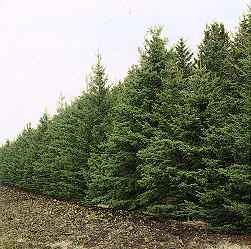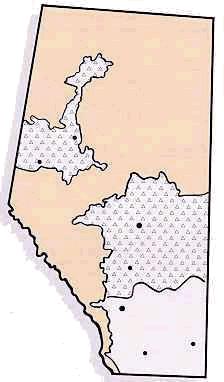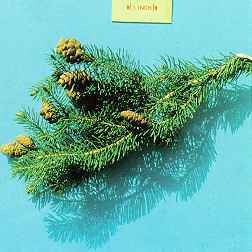| | Plant characteristics | Site preference | Hardiness | Uses | Problems | Diseases | Insects | Pruning
.

Scientific Name: Picea glauca (Moench) Voss.
Plant Characteristics
Native to North America. Found in a variety of soil types and climatic regions and is common throughout south-central and northern regions of Alberta. It is rarely found in a pure stand, but mixed with other species.
Dense evergreen with a uniform conical-shaped crown and may reach the height of 20 to 25 m (65 to 80 ft), with a spread up to 6 m (20 ft). The tree has a moderate growth rate.
White spruce is a very long lived tree, 50 to 100 years. It can grow from 30 to 60 cm (12 to 24 in.) a year till maturity.
Leaves - Leaves are needle-shaped, four sided in a cross section, usually less than 19 mm (0.75 in.). Needles are long, straight, stiff, sharply pointed, bluish green, aromatic when crushed. Needles are rather soft and not stiff and prickly.
Cones - Cones are brown, cylindrical in shape, 4 to 5 cm (1.5 to 2 in.) in length, at the ends of twigs, yellow when turning, brown when mature, smooth margins. Cones open about September and drop during winter or spring.
Bark - Scaly, thin, grey to ashy brown.
Site Preference
White spruce is adapted to well drained, somewhat dry soils through to soils that are poorly drained. It has best growth on well drained, silty soils that have adequate available moisture. Can withstand flooding during the growing season, but does
not like to stand in water.
White spruce will survive while exposed to short periods of low moisture, but will not perform well on dry sites.
It has high shade tolerance and can tolerate completely shaded conditions. Intolerant of saline conditions, but has high acid tolerance.
Hardiness
Very winter hardy.
.


Uses
This is our most valuable evergreen tree for shelterbelt planting. It is most commonly used in multi-row shelterbelts as an inside row. Recommended spacing is 2 to 4 m (6 to 13 ft) between trees in a row and 5 to 8 m (16 to 26 ft) away from adjacent rows. Since spruce cannot compete with faster growing poplars and willows, ample space must be provided between rows. White spruce is also very useful as an ornamental either by itself, or in groupings. The tree provides cover and protection for wildlife. The seeds are used for food by some species and occasionally deer may browse branches.
Problems
Young seedlings require protection from sun because they are susceptible to sun scald.
Diseases
Susceptible to needle rust.
Insects
Susceptible to spruce sawfly, spruce gall aphid and white pine weevil, pine-needle scale, and occasionally damaged by severe spider-mite infestations.
Pruning
Pruning is not required, unless it has double leaders, when one should be removed. If no leaders are present a new leader must be trained. If infested with white pine weevil, the growing tip must be removed and burned.
.

Shelterbelts Varieties for Alberta provides information on a number of other trees and shrubs than may be suitable for shelterbelts.
Visit our website directory for the Reforestation Woodlot Listings. |
|